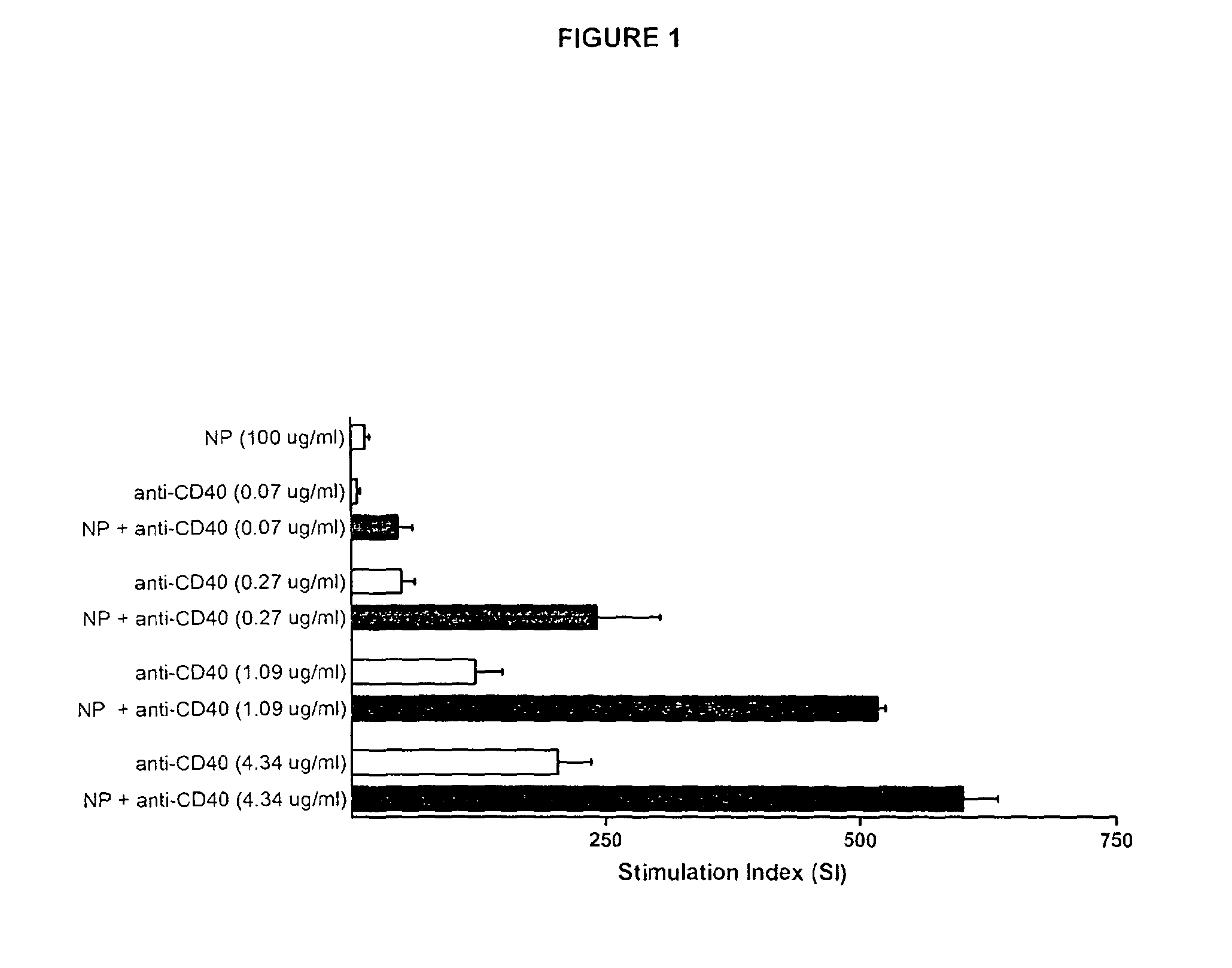Compositions comprising polyglutamic acid nanoparticles and CD40 agonists
a technology of cd40 and polyglutamic acid, which is applied in the direction of snake antigen ingredients, viral antigen ingredients, peptide sources, etc., can solve the problems of shock syndrome, side effects, and insufficient response to eliminate malignant cells, and achieves convenient and robust protocol, less loss of functional activity, and fast and robust
- Summary
- Abstract
- Description
- Claims
- Application Information
AI Technical Summary
Benefits of technology
Problems solved by technology
Method used
Image
Examples
example 1
Synergistic Activation of CD40 by a Mixture of γ-PGA Nanoparticles and Anti-CD40 Antibodies
Introduction
[0152]The invention provides drug formulations composed of nanoparticles and protein drugs that significantly increase their therapeutic effect. The formulations have the potential to increase agonistic properties, increase the cross linking of protein drugs targeting immunoregulatory molecules, increase the duration and tissue retention of the drug. They have furthermore the potential to function as controlled release vehicle and reduce the dosing frequency and thereby increased patient convenience and reducing the risk of systemic leakage and thus systemic side effects. The described synergistic effect is demonstrated herein on the CD40, but also extends to other immunoregulatory and other cell receptors, as well as combinations of receptors. The invention thus provides significant benefits to treatment of cancer (immunotherapy), vaccination (cancer, virus etc) as well as HIV / AID...
example 2
Anti-CD40 Antibodies are Adsorbed on to the Surface of γ-PGA Nanoparticles
Materials & Methods
[0167]In order to investigate the extent to which freely mixed CD40 antibodies are adsorbed on the surface of γ-PGA nanoparticles, a mixture of γ-PGA nanoparticles (100 μg / ml) and anti-CD40 antibodies (B44, 4.3 μg / ml) was incubated for 15 min at 4° C. The mixture was then centrifuged at 13000 rpm for 10 min and the supernatant removed. The remaining pellet was resuspended to a fixed nanoparticle concentration and a sample was withdrawn.
[0168]This procedure was then repeated twice for a total of three washes.
[0169]Proliferation was assessed on human CD19+ B-cells stimulated for 72 h with a fresh mix of γ-PGA nanoparticles and anti-CD40 antibodies (wash 0) or the anti-CD40 antibody / γ-PGA nanoparticle mix retrieved after wash 1, 2 or 3. Data were obtained from two separate experiments on different donors, and values were scaled according to a calculated normalization factor.
Results
[0170]Results...
example 3
Comparison of Different Nanoparticles
Materials & Methods
[0172]Human CD19+ B-cells were cultured with 100 μg / ml of γ-PGA nanoparticles or plain polylactide nanoparticles (250 nm size, Corpuscular Inc., Cold Spring, N.Y., USA), with or without anti-CD40 antibodies (4.3 μg / ml). Untreated cells were used as control and proliferation was assayed after 72 h. Data were obtained from four separate experiments on different donors and values were scaled according to a calculated normalization factor.
Results
[0173]Results from the nanoparticle comparison studies are shown in FIG. 7.
[0174]The unexpected synergistic effect on B cell stimulation demonstrated in Example 1 for the exemplary γPGA nanoparticle composition of the invention was not observed for a nanoparticle composition comprising plain polylactide nanoparticles mixed with an anti-CD40 antibody (using the mixing protocol described in Example 1 above).
[0175]PLGA and PLA micro-particles (Poly(lactide-co-glycolide) and poly(lactide acid))...
PUM
| Property | Measurement | Unit |
|---|---|---|
| diameter | aaaaa | aaaaa |
| mean particle diameter | aaaaa | aaaaa |
| mean particle diameter | aaaaa | aaaaa |
Abstract
Description
Claims
Application Information
 Login to View More
Login to View More - R&D
- Intellectual Property
- Life Sciences
- Materials
- Tech Scout
- Unparalleled Data Quality
- Higher Quality Content
- 60% Fewer Hallucinations
Browse by: Latest US Patents, China's latest patents, Technical Efficacy Thesaurus, Application Domain, Technology Topic, Popular Technical Reports.
© 2025 PatSnap. All rights reserved.Legal|Privacy policy|Modern Slavery Act Transparency Statement|Sitemap|About US| Contact US: help@patsnap.com



